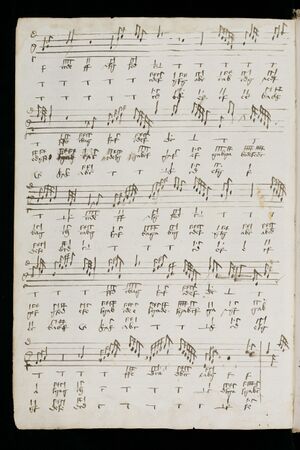Old German Tablature Notation

The term "Old German Tablature" refers to a style of notation popular among German-speaking organists in the 15th and 16th century. Unlike the "new" notation, it was only rarely used to write down compositions not to be played on a keyboard instrument. Surviving examples show that it could readily support pieces between two and ten voices.
Overview
The defining feature of old German tablature is the usage of black mensural notation for the voice that is highest in pitch (the superius, as it is often referred to). The organist is usually expected to play this voice in their right hand, using their other hand and both feet to play the lower voices, which are invariably given in letters. The specific style of notation varies significantly between manuscripts, but a few common elements can be observed:
- In the superius, all stems point upwards, and a downward stem is used to denote chromatic inflections (if it appears plain or crossed with a short, diagonal stroke) or ornamentation (with a loop at its end). Some scribes allow for downward stems that are both crossed and looped, some prefer to only denote the ornament in such cases. Depending on the source, a triangular flag on a note may denote triplet rhythm. In the last third of the 15th century, a curious form of shorthand emerged - in a passage of many notes moving in uniform values, only the first is given with the appropriate amount of flags, while the rest are notated as noteheads only.
- In the lower voices, the symbols used generally agree with what is now known as Helmholtz pitch notation: the letters C, D, E, F, G, A, H belong to the white keys, while for the black keys a specific set of Cis, Es, Fis, Gis, B is used. These are used even in contexts where the enharmonic spelling should be preferable (presumably for the sake of convenience), with minimal exceptions. At first, the symbols of the black keys may prove difficult to recognise: the raised tones are only written with the base letter and a long S next to it, the I being omitted, and Es, despite being written without any shorthand, tends to become distorted by the scribe's handwriting. In terms of octave displacement, a lowercase letter belongs to the octave directly below Middle C, and an uppercase letter (only in 16th century sources) to the octave below that; for octaves above Middle C, horizontal lines should be progressively added above the lowercase letter. Note that, as the higher ranges were usually occupied by the superius, it is rare for the letters to intrude into the double-dashed octave - the specific implementation tends to vary between sources, with some lacking the provisions for such notation entirely. The rhythm is denoted with dots and vertical lines above the letters. Given that the shapes of the notes must agree between the superius and the letters below, a note with a dot above its letter has the note value of a semibrevis (in richly ornamented works of the Paulomimes, semisemifusae are a common sight).
- Where measure lines were not written, the scribe denoted the limits of a measure with minute horizontal gaps between groups of letters. A "=" symbol, sometimes vertical, is often used when a measure is cut off prematurely at a page's right margin, to let the reader know that its continuation will follow. Notes can be, and ocassionally are, written across barlines. It is generally safe to assume that both the tempus and prolatio are imperfect.
Scribal errors happen often, as are intentional omissions of commonly understood interpretative details, and they are of different nature when occuring in the superius, as opposed to occuring in the lower voices. It is common for the entirety of the superius to be written without any accidentals or for some of its notes to have an incorrect rhythmic value assigned (whether by an inappropriate usage of stems, or flags). Somewhat less frequently, accidentals were left out in the lower voices as well. Sections of the top voice are also prone to being written a line too high or too low, producing unmusical results. Just like with normal mensural notation, there are many cases where the total length of a measure in the superius does not match itself as given by the letters.
Specific manuscripts
Details and links will be added soon.
Ileborgh Tablature
The letter notation in this source is unique: to save space, the two-voiced accompaniment is written horizontally, so that a pair of letters always takes up the space below a single "measure" in the superius. It is commonly accepted that this signifies the usage of double pedal, the left letter being intended for the left foot and likewise on the right side. Further comment on this manuscript is precluded by lack of access to its facsimile or published research of acceptable quality.
Lochamer-Liederbuch
The Buxheim organ book
Tabulaturen etlicher Lobgesang
References
Kite-Powell, J. (2022) German Keyboard Tablature. https://www.academia.edu/53290890/German_Keyboard_Tablature